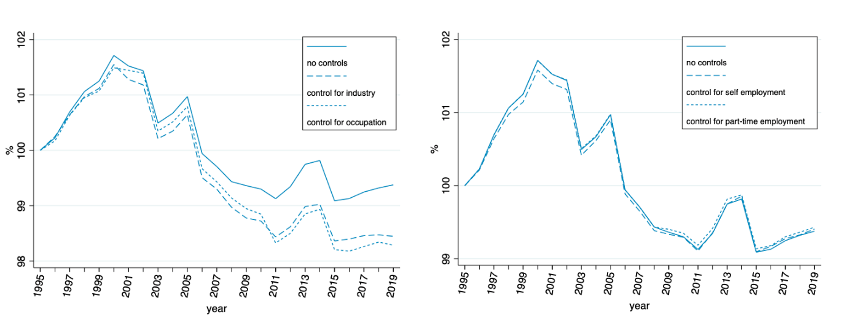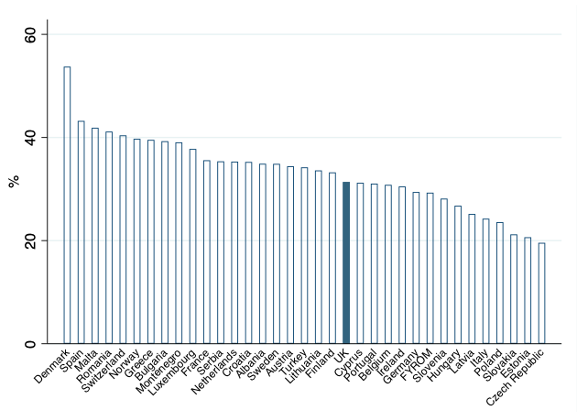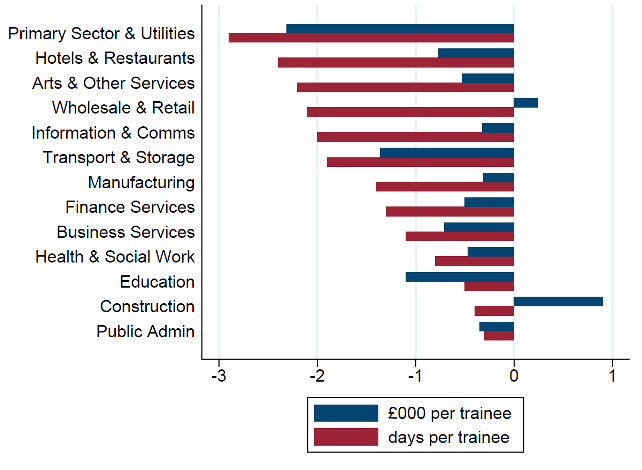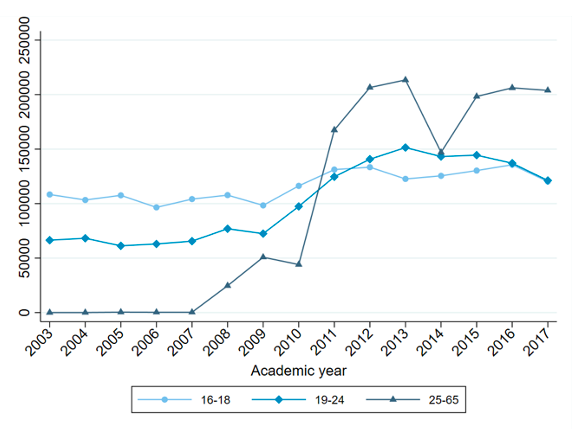COVID-19 has prompted changes in consumer spending patterns, business practices and working arrangements, many of which are likely to persist beyond the crisis with implications for the demand for certain occupations or skills. To date, workers in low paid occupations and sectors, and those that are younger, have suffered the most in the labour market, threatening to widen inequalities and damage social mobility into the future.
Increased investment in skills and training – including of the existing workforce – was already called for before the pandemic (see, for example, the LSE Growth Commission) in order to address longstanding skills gaps, improve UK productivity performance, and build resilience to technological change. Given the labour market displacement caused by the pandemic, ongoing (accelerated) technical change and the zero-carbon transition, this need is all the more urgent. Investments in individuals’ skills can help mitigate the risks of costly labour market scarring by helping build resilience to change and employability in new occupations or sectors where demand is growing.
In our recent report, we combine a wide range of data sources to document trends in job-related training over recent decades. We also offer some possible interpretations for the observed changes over time and discuss some policy proposals with relevance in light of the current crisis and beyond.
The last two decades have seen a general decline in job-related training, as reported by workers
There has been a general decline in training participation since the early 2000s (Figure 1), which is not explained by shifts in sectoral or occupational composition or changing working arrangements. The decline in training rates has been particularly felt by more educated and younger workers and by those in technical occupations, whereas lower skilled workers have consistently received less training.
Figure 1. Training participation rate in the UK, relative to 1995
A. Industry and occupation B. Part-time and self-employed 
Notes: Sample includes workers (employed and self-employed) aged 16-65 in private sector. The solid lines show participation rates relative to the level in 1995. The dashed lines control for changes in the composition of the labour market by industry, occupation and types of employment as indicated. Source: Quarter 2 UK LFS (1995-2019).
Our analysis also shows that the observed decline in training participation was not compensated by individuals receiving training of a longer duration or improved “quality”.
Indeed, country-level statistics from the European Working Conditions Survey show that while UK participation rates are relatively high in an international comparison, the duration of the average training course is shorter in the UK relative to its peers (Figure 2). Moreover, the UK ranks only 27th out of 35 countries in terms of the share of trainees who strongly agree that their training has helped to improve the way they work.
Figure 2. International comparison in the share of training of at least 6 days duration

Notes: Aged 16-65 employed, including self-employed. Source: European Working Conditions Survey, 2015.
Firm level data from the Employers Skills Survey over the period 2011 and 2017 shows that while training participation reported by firms has remained constant, the number of training days and training expenditure per trained employee has fallen by 18 per cent and 17 per cent respectively. As reported in Figure 3, this reduction has affected virtually all sectors.
Figure 3. Change in expenditure and training days per trainee by industry, 2011-2017

Note: Expenditure deflated in 2017 price using an economic-wide inflation measure. Source: Employer Skills Survey 2018 report
Publicly funded training participation has risen, but there are also concerns around quality. Against this backdrop of declining training participation in the aggregate, publicly-funded training programmes – notably apprenticeships – have grown in importance in England in recent decades. Our analysis of government administrative data reveals that, thanks to a large increase in apprenticeship starts, the share of workers participating in apprenticeships has grown from about 0.8 per cent in 2003 to 1.7 per cent in 2017. Since 2007, much of this growth can be accounted for by the expansion of apprenticeships among 25-65 year old workers; This can clearly be seen in Figure 4, which plots the evolution in the number of yearly apprenticeship starts across three main age groups. It is important to note that the expansion in apprenticeship numbers has been accompanied by a reduction of their duration since 2003.
Figure 4. Apprenticeship starts by apprentices’ age group

Notes: Apprenticeship starts count the number of new apprenticeships started during the academic year (August – July) in England. Source: Own figures from ILR (Department for Education).
Training has taken a hit since the onset of the COVID-19 crisis
We find that pre-pandemic training rates have tended to be lower in the sectors and occupations where working at home is less prevalent, suggesting that many of those most affected by the crisis in labour market terms have also tended to receive less training in the past.
Amongst those in employment, the training rate in the first two quarters of 2020 declined sharply. This is to be expected since training tends to be a discretionary expenditure for firms, and given the disruptions to business operations experienced by many firms. More granular analysis suggests that this decline has been steeper amongst younger, less educated workers.
Figure 5. Training rate since the pandemic 
Notes: Sample includes workers (employed and self-employed) aged 16-65 in private sector, LFS person weights applied. The red line shows the training rate relative to its level in Q3 – 2019 normalised to 100; over the four quarters since. Source: Quarterly Labour Force Survey, 2015 to 2020, UK.
Implications for policy
The trends we outline and the broader evidence suggest that new or enhanced policies to increase the quantity and quality of job-related training are required, particularly for younger workers or those with lower levels of educational attainment who have historically received little training and have borne the brunt of the recent economic disruption. There are some indications that firms may be reluctant or unable to invest more in their employees’ training due to concerns about returns to training (especially training in increasingly important transferable skills) and tightening financial budgets. This calls for more action from the government to provide firms with the right incentives. Increased support for adult education and training announced since the onset of COVID-19, including the National Skills Fund, and short-term incentives for apprentices are a welcome first step in this direction. In our report we sketch out some additional policy proposals:
- Human capital tax credits: Akin to existing R&D tax credits, they would incentivise investment in workforce training by offering a tax relief to financially constrained firms. This could be piloted in sectors where displacement has been particularly acute, or anticipated (e.g. greening the car industry).
- A more broadly defined apprenticeship levy: In its current version the levy risks favouring training of more experienced workers rather than young people (for whom apprenticeships may be more adequate). Reforms should be considered to target younger workers with apprenticeships while broadening the use of levied funds for adult workers.
- Further devolution of skills policy: Further devolution of apprenticeship and training policy should be considered where better local knowledge of skills gaps can increase its effectiveness.
- Job creation and retraining schemes: Embedding re-skilling or up-skilling in new programmes of job creation, including those associated with net-zero-aligned investments – with stronger incentives for businesses and support for individuals.
♣♣♣
Notes:
- This blog post expresses the views of its author(s), not the position of LSE Business Review or the London School of Economics.
- Featured image by ThisisEngineering RAEng on Unsplash
- When you leave a comment, you’re agreeing to our Comment Policy
 Jiaqi Li is a research assistant for Dr. Anna Valero and a MRes/PhD student at Warwick University. Previously, he was a research economist at National Institute of Economic and Social Research, while undertaking MSc at Warwick.
Jiaqi Li is a research assistant for Dr. Anna Valero and a MRes/PhD student at Warwick University. Previously, he was a research economist at National Institute of Economic and Social Research, while undertaking MSc at Warwick.
 Guglielmo Ventura is a research assistant at LSE’s Centre for Economic Performance’s Centre for Vocational Education Research. His research interests include education, labour markets and policy evaluation.
Guglielmo Ventura is a research assistant at LSE’s Centre for Economic Performance’s Centre for Vocational Education Research. His research interests include education, labour markets and policy evaluation.
 Anna Valero is ESRC innovation fellow at LSE’s Centre for Economic Performance (CEP).
Anna Valero is ESRC innovation fellow at LSE’s Centre for Economic Performance (CEP).





